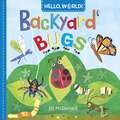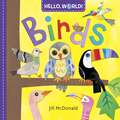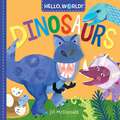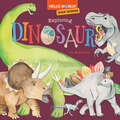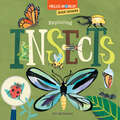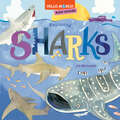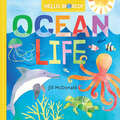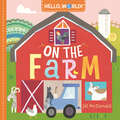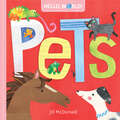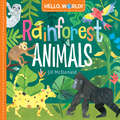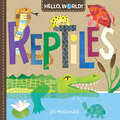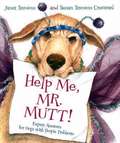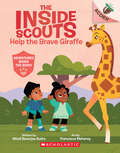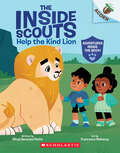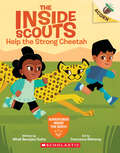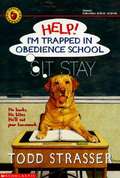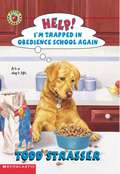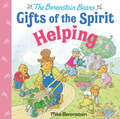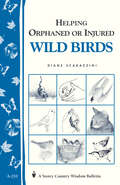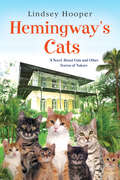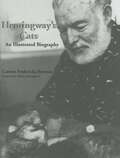- Table View
- List View
Hello, World! Backyard Bugs (Hello, World!)
by Jill McDonaldHello, World! is a series designed to help parents introduce simple nonfiction concepts to their babies and toddlers. Now even the youngest children can enjoy learning about the world around them! Told in simple terms and accompanied by bright, cheerful illustrations, Hello, World! makes learning easy for young children and offers useful prompts to the adult reader in order to help them engage with their child on each page. Every young child loves to look at bugs. Now they can learn all about the insects in their backyards—with colors, sounds, sizes, and super-simple facts (&“Chomp! A bright red ladybug munches on a leaf. Point to each of its spots.&”). It&’s a perfect way to bring the outside world of natural science into the busy world of a toddler, where learning never stops.
Hello, World! Birds (Hello, World!)
by Jill McDonaldHello, World! is a series designed to help parents introduce simple nonfiction concepts to their babies and toddlers. Now even the youngest children can enjoy learning about the world around them. Told in simple terms and accompanied by bright, cheerful illustrations, Hello, World! makes learning easy for young children and offers useful prompts to the adult reader in order to help them engage with their child on each page. Every young child loves to look up at birds in the sky. Now they can learn all about a variety of birds—with colors, shapes, sizes, and super-simple facts (&“Peck, peck, peck! This noisy woodpecker is looking for food inside a tree trunk.&”). It&’s a perfect way to bring the outside world of natural science into the busy world of a toddler, where learning never stops.
Hello, World! Dinosaurs (Hello, World!)
by Jill McDonaldLearn from home and explore the world with these fun and easy board books!All young children love dinosaurs. Here&’s a Hello, World! board book that teaches toddlers all about Triceratops, Stegosaurus, T-rex, and many more—with colors, shapes, sizes, and super-simple facts. Hello, World! is a series designed to introduce first nonfiction concepts to babies and toddlers. Told in clear and easy terms (&“T. rex&’s arms were very small, even though its body was large&”) and featuring bright, cheerful illustrations, Hello, World! makes learning fun for young children. And each sturdy page offers helpful prompts for engaging with your child. It&’s a perfect way to bring science and nature into the busy world of a toddler, where learning never stops. Look for all the books in the Hello, World! series: • Solar System• Weather• Backyard Bugs• Birds• Dinosaurs• My Body• How Do Apples Grow?• Ocean Life• Moon Landing• Pets• Arctic Animals• Construction Site• Rainforest Animals• Planet Earth • Reptiles• Cars and Trucks • Music• Baby Animals• On the Farm• Garden Time• Planes and Other Flying Machines• Rocks and Minerals• Snow
Hello, World! Kids' Guides: Exploring Dinosaurs (Hello, World!)
by Jill McDonaldWith 2 million board books sold, Hello, World! has become a trusted toddler-and-preschool series. Now there are Hello, World! Kids' Guides, all-new picture books with a higher reading level and a deeper exploration into each topic.In Exploring Dinosaurs, readers can learn all about prehistoric creatures, with favorites such as T. rex and Stegosaurus, mini dinosaurs the size of a turkey, and even a swimming dinosaur. Dinosaur fans will find:Fascinating details about dinosaurs from the Triassic, Jurassic, and Cretaceous periods.Panels of stats for kids who love data, with information about size, body parts, diet, and more.Questions that ask the reader to think about dinosaurs in relation to themselves, such as "If you discovered a dinosaur, what would you call it?"Loyal Hello, World! fans who are reading on their own, as well as any kid who loves nonfiction, will find many captivating hours of learning and inspiration.
Hello, World! Kids' Guides: Exploring Insects (Hello, World!)
by Jill McDonaldWith 2 million board books sold, Hello, World! has become a trusted toddler-and-preschool series. Now there are Hello, World! Kids' Guides, all-new picture books with a higher reading level and a deeper exploration into each topic.In Exploring Insects, readers can learn all about bugs, with pollinators like bees and butterflies, incredible rainforest insects, and even an insect that uses its butt to warn off predators! Insect fans will find:Fascinating details about bugs and how they help the environment.Panels of stats for kids who love data, with information about body parts, diet, location, and more.Questions that ask the reader to think about insects in relation to themselves, such as "If you had wings, where would you fly to?"Loyal Hello, World! fans who are reading on their own, as well as any kid who loves nonfiction, will find many captivating hours of learning and inspiration.
Hello, World! Kids' Guides: Exploring Sharks (Hello, World!)
by Jill McDonaldThe best-selling Hello, World! board book series expands into picture books, for Hello, World! kids who are ready for the next step.Kids who love sharks will enjoy this lively, fact-filled, illustrated tour of the world's oceans, with engaging information on every page: • Fascinating details about favorite sharks, from whale sharks to mini sharks, plus information about prehistoric sharks, shark relationships with other animals, and careers helping sharks that kids can aspire to. • Statistics about each shark, with information about size, location, swimming speed, lifespan, and more. • A question on each page that asks the reader to think about sharks in relation to themselves, such as "If you were a shark, what kind of tail would you want?" and "What ways can you think of to help protect sharks?"Hello, World! readers who have moved up to picture books and any kids who love science and ocean creatures will find many captivating hours of learning and inspiration in the launch of this exciting new series.
Hello, World! Ocean Life (Hello, World!)
by Jill McDonaldLearn from home and explore the world with these fun and easy board books!All young children love to play in the waves at the beach. Here's a Hello, World! board book that teaches them all about oceans and the creatures and plants that live there.Hello, World! is a series designed to introduce first nonfiction concepts to babies and toddlers. Told in clear and easy terms ("An octopus has eight arms. Can you count them all?") and featuring bright, cheerful illustrations, Hello, World! is a perfect way to bring science, nature, and culture into the busy world of a toddler, where learning never stops. Look for all the books in the Hello, World! series: • Solar System• Weather• Backyard Bugs• Birds• Dinosaurs• My Body• How Do Apples Grow?• Ocean Life• Moon Landing• Pets• Arctic Animals• Construction Site• Rainforest Animals• Planet Earth • Reptiles• Cars and Trucks • Music• Baby Animals• On the Farm• Garden Time• Planes and Other Flying Machines• Rocks and Minerals• Snow
Hello, World! On the Farm (Hello, World!)
by Jill McDonaldLearn from home and explore the world with these fun and easy board books!Babies and toddlers get to visit a farm in this lively and informative addition to the hit Hello, World! board book series. Children can learn all about plants that grow, animals that help, and farmers who work hard, with easy-to-understand facts and bright pictures of rural life.Hello, World! board books introduce first nonfiction concepts to babies and toddlers. Told in clear and easy words with simple facts ("This red tractor is used for plowing, planting, and harvesting crops") and featuring bright, cheerful illustrations, Hello, World! makes learning fun for young children. It's a perfect way to bring science and nature into the busy world of a toddler, where learning never stops. Look for all the books in the Hello, World! series: • Solar System• Weather• Backyard Bugs• Birds• Dinosaurs• My Body• How Do Apples Grow?• Ocean Life• Moon Landing• Pets• Arctic Animals• Construction Site• Rainforest Animals• Planet Earth • Reptiles• Cars and Trucks• Music• On the Farm• Baby Animals
Hello, World! Pets (Hello, World!)
by Jill McDonaldLearn from home and explore the world with these fun and easy board books!Toddlers can learn all about different pet types and how to be a great animal companion with the popular Hello, World! board book series, with easy-to-understand facts about cats, dogs, rabbits, and even less fuzzy pets, such as fish, frogs, and lizards.Hello, World! is a series designed to introduce first nonfiction concepts to babies and toddlers. Told in clear and easy terms ("Fish have lived on Earth since before the dinosaurs!") and featuring bright, cheerful illustrations, Hello, World! makes learning fun for young children. And each page offers helpful prompts for engaging with your child. It's a perfect way to bring science and nature into the busy world of a toddler, where learning never stops. Look for all the books in the Hello, World! series: • Solar System• Weather• Backyard Bugs• Birds• Dinosaurs• My Body• How Do Apples Grow?• Ocean Life• Moon Landing• Pets• Arctic Animals• Construction Site• Rainforest Animals• Planet Earth • Reptiles• Cars and Trucks • Music• Baby Animals• On the Farm• Garden Time• Planes and Other Flying Machines• Rocks and Minerals• Snow
Hello, World! Rainforest Animals (Hello, World!)
by Jill McDonaldThe latest in the hit Hello, World! board book series teaches toddlers all about the amazing world of a rainforest—with easy-to-understand facts about the incredible animals who make their home there.Hello, World! is a series designed to introduce first nonfiction concepts to babies and toddlers. Told in clear and easy terms ("Croak! What's that sound? It's the red-eyed tree frog.") and featuring bright, cheerful illustrations, Hello, World! makes learning fun for young children. And each page offers helpful prompts for engaging with your child. It's a perfect way to bring science and nature into the busy world of a toddler, where learning never stops. Look for all the books in the Hello, World! series: Solar System, Weather, Backyard Bugs, Birds, Dinosaurs, My Body, How Do Apples Grow?, Ocean Life, Moon Landing, Pets, Arctic Animals, and Construction Site.
Hello, World! Reptiles (Hello, World!)
by Jill McDonaldLearn from home and explore the world with these fun and easy board books!The latest in the hit Hello, World! board book series teaches toddlers all about reptiles—with easy-to-understand facts about snakes, lizards, turtles, tortoises, crocodiles and alligators.Hello, World! is a series designed to introduce first nonfiction concepts to babies and toddlers. Told in clear and easy terms ("Green pythons are born red or yellow. They turn green in their first year") and featuring bright, cheerful illustrations, Hello, World! makes learning fun for young children. And each page offers helpful prompts for engaging with your child. It's a perfect way to bring science and nature into the busy world of a toddler, where learning never stops. Look for all the books in the Hello, World! series: • Solar System• Weather• Backyard Bugs• Birds• Dinosaurs• My Body• How Do Apples Grow?• Ocean Life• Moon Landing• Pets• Arctic Animals• Construction Site• Rainforest Animals• Planet Earth • Reptiles• Cars and Trucks • Music• Baby Animals• On the Farm• Garden Time• Planes and Other Flying Machines• Rocks and Minerals• Snow
Help Find Honey! (Pet Finders Club #10)
by Ben M. BaglioHoney, a famous show-ring Chihuahua, disappears from the grooming parlor.
Help Me, Mr. Mutt!
by Janet StevensResponding to disgruntled dogs nationwide, Mr. Mutt, Canine Counselor, has solutions to the most sticky dilemmas. But Mr. Mutt has his own problem to solve: the cat (aka The Queen), who has her own idea of who's in charge. Now Mr. Mutt is the one who needs help--quick! Through letters and newspaper clippings--and with plenty of their trademark humor--Janet Stevens and Susan Stevens Crummel give voice to despairing dogs everywhere.
Help Wanted: One Rooster
by Julie FalatkoThe search for the perfect rooster to save a struggling farm from chaos will leave readers howling—and trying out their very best cock-a-doodle-doo!A farm.Bucolic beauty, barns, and...sleepy animals everywhere?This farm needs a rooster, and Cow is determined to find the perfect candidate.One rooster, who wakes up first thing in the morning, with a resounding cock-a-doodle-do—is that too much to ask?YES!This tale of a frenzied farm and the beleaguered cow trying to keep it all together packs more than laughs. As each enthusiastic candidate learns: roostering isn&’t what you are, but what you do. And there&’s room for everyone. As long as they wake up early—er, I mean brew strong coffee—or is it press the big button?—oh never mind. All are welcome!
Help the Brave Giraffe: An Acorn Book (The Inside Scouts)
by Mitali Banerjee RuthsThe Inside Scouts help a giraffe with an upset tummy feel better in this full-color early reader series!Pick a book. Grow a Reader!This series is part of Scholastic's early reader line, Acorn, aimed at children who are learning to read. With easy-to-read text, a short-story format, plenty of humor, and full-color artwork on every page, these books will boost reading confidence and fluency. Acorn books plant a love of reading and help readers grow!Viv and Sanjay are the Inside Scouts! Together, they help animals. They have a cool superpower -- they can shrink super small. A giraffe can't eat because her tummy feels sick. The Inside Scouts put on their suits, grab their tools, and get really small! They go inside the giraffe to find out what is stuck in her gut. And they work together to help the giraffe feel better!This series introduces beginning readers to the human body through mammals with similar anatomy -- and it does so in really fun ways! In this book, readers learn about the digestive system as Viv and Sanjay fix a giraffe's upset stomach! With color-coded speech bubbles, easy-to-read text, and light nonfiction content, these engaging STEM-themed stories are the perfect fit for new readers!
Help the Kind Lion: An Acorn Book (The Inside Scouts)
by Mitali Banerjee RuthsInside Scouts Viv and Sanjay help a lion with a leaky heart in this full-color early reader series!Pick a book. Grow a Reader!This series is part of Scholastic's early reader line, Acorn, aimed at children who are learning to read. With easy-to-read text, a short-story format, plenty of humor, and full-color artwork on every page, these books will boost reading confidence and fluency. Acorn books plant a love of reading and help readers grow!Viv and Sanjay are the Inside Scouts! Together, they help animals. They have a cool superpower -- they can shrink super small. When a lion with a leaky heart needs help, the Inside Scouts know what to do! They put on their suits, grab their tools, and get really small. They go inside the lion to find the leaky spot. And they fix it together!This series introduces beginning readers to the human body through mammals with similar anatomy -- and it does so in really fun ways! In this first book, readers learn about the circulatory system as Viv and Sanjay fix the lion's heart! With color-coded speech bubbles, easy-to-read text, and light nonfiction content, these engaging STEM-themed stories are the perfect fit for new readers!
Help the Strong Cheetah: An Acorn Book (The Inside Scouts)
by Mitali Banerjee RuthsThe Inside Scouts help a cheetah with a hurt leg feel better in this full-color early reader series!Pick a book. Grow a Reader!This series is part of Scholastic's early reader line, Acorn, aimed at children who are learning to read. With easy-to-read text, a short-story format, plenty of humor, and full-color artwork on every page, these books will boost reading confidence and fluency. Acorn books plant a love of reading and help readers grow!Viv and Sanjay are the Inside Scouts! Together, they help animals. They have a cool superpower -- they can shrink super small. A cheetah got a cramp in her leg while she was running. Now she can't move her leg. The Inside Scouts put on their super-suits, grab their tools, and get really small! They go inside the cheetah's leg to stop the cramp. And they work together to help her muscle relax!This series introduces beginning readers to the human body through mammals with similar anatomy -- and it does so in really fun ways! In this book, readers learn about the muscular system as Viv and Sanjay fix a cheetah's leg! With color-coded speech bubbles, easy-to-read text, and light nonfiction content, these engaging STEM-themed stories are the perfect fit for new readers!
Help! I'm Trapped In Obedience School
by Todd StrasserWhile showing off a weird machine to his friends, Jake Sherman accidentally turns his best friend, Andy, into a dog! Can Jake turn Andy back into a human? <p> <p><b>Lexile Level: 550L</b></p>
Help! I'm Trapped in Obedience School Again
by Todd StrasserAndy borrows his friend Jake's dog in order to meet the new girl in town, who also has a dog. Sounds simple? Nope... <p> <p><b>Lexile Level: 570L</b></p>
Helping (Berenstain Bears Gifts of the Spirit)
by Mike BerenstainWhile Mama Bear is away, Papa thinks he can handle everything. The cubs offer to help out when Papa learns that he bit of more than he can chew in this humorous Berenstain Bears Gifts of the Spirit storybook!Families will enjoy this sweet, faith-based story filled with fun, colorful illustrations—it&’s the perfect read-aloud for any day!When Papa Bear makes a mess of things while Mama is away, the cubs come to the rescue with a little help around the house! This 32-page hardcover storybook, created by Mike Berenstain, son of Stan and Jan Berenstain, includes a soon-to-be classic story about the joy of helping others.The Berenstain Bears Gifts of the Spirit series celebrates the joy of faith, family, and friends—values essential to a wholesome and fulfilling life!
Helping Orphaned or Injured Wild Birds: Storey's Country Wisdom Bulletin A-210 (Storey Country Wisdom Bulletin Ser.)
by Diane ScarazziniTo Help or Not to Help? When faced with an injured bird or orphaned nestling, most people want to help but don’t know how – and also fear doing more harm than good. In fact, many wild birds that appear to be in trouble don’t need assistance at all. How do you know whether a bird needs help? How do you know what sort of help the bird needs? In Helping Orphaned or Injured Wild Birds, you’ll find all the information you need on when and how to assist all kinds of birds, from wrens to raptors. You’ll learn how to: Identify whether a bird needs rescuingHelp a baby bird that’s fallen from its nestIdentify the age and species of an injured of orphaned birdPrepare emergency rations for a baby birdAdminister basic bird first-aid Locate a professional wildlife rehabilitator
Hematology Techniques and Concepts for Veterinary Technicians
by Gregg L. Voigt Shannon L. SwistNow in full color, Hematology Techniques and Concepts for Veterinary Technicians, Second Edition is a thorough update to this introduction to the fundamental concepts of collecting, handling, and preparing hematology samples. Covering the basics of blood composition, cell morphology, and sample collection, handling, and preparation, the book is designed specifically for veterinary technicians and students to gain a full understanding of why each test is performed and ensure accurate test results. In addition to addressing advances in technology, equipment, and test techniques throughout, a new chapter covers automated testing, and a companion website provides review questions and images from the book for download at www.wiley.com/go/voigt. Key concepts have also been added to each chapter to better promote learning, and terms are now defined throughout the text, with the definitions collected into a glossary. User-friendly and well-illustrated with charts, reference values, algorithms and photomicrographs, Hematology Techniques and Concepts for Veterinary Technicians, Second Edition is a key reference for veterinary technicians and veterinary technology students.
Hematology Techniques and Concepts for Veterinary Technicians (2nd edition)
by Gregg L. Voigt Shannon L. SwistThe major reason for the preparation of this second edition is to introduce the veterinary technology student to new technology, equipment, and test techniques that are becoming more available in the field of veterinary hematology. The intent of the new edition remains the same as in the previous edition. It is an introductory overview of veterinary hematology and a guide for the student to learn the fundamental concepts of collecting, handling, preparing, and testing blood and other samples in the hematology laboratory. It is not intended as a diagnostic aid, differential disease discussion, or complete atlas of blood cells.
Hemingway's Cats
by Lindsey Hooper&“ONE CAT JUST LEADS TO ANOTHER.&” —Ernest HemingwayInspired by the true story of the famous six-toed felines of the Ernest Hemingway House in Key West, Florida—and the hurricane that nearly blew them away—Hemingway&’s Cats is a delightful novel full of romance, humor, and lots and lots and lots of cats . . . Laura Lange didn&’t come to Key West to fall in love. As a recent college grad—with a useless degree in English—she came to work at the historic Hemingway home as a tour guide. Why not? She wrote her thesis on the iconic author. She has no other job offers. And she&’s desperate. Now Laura is falling desperately in love—with the fifty-four frisky felines who freely roam the estate. These descendants of Hemingway&’s original cat have not only stolen her heart—they&’re changing her life in ways she never imagined . . . First there&’s Nessie, the bushy-tailed &“house mother&” of the cats who seems to have adopted Laura, too. Then there&’s grumpy old Pawpa Hemingway; the cat thieves Chew-Chew and Whiskey; the big-pawed Boxer and Bullfighter; and dozens of darling kittens. The locals are lovable, too. Laura&’s having a great time with her boy-crazy bungalow roomies, the Crabb sisters, and especially the young, handsome cat keeper, Jake. But Laura&’s summer of fun is about to take an unexpected turn—a Category 5 hurricane is about to make landfall directly on their doorstep . . . They can&’t possibly evacuate fifty-four cats. So Laura, Nessie, and all of their friends decide to hunker down in the Hemingway House to weather this storm—together.&“Sweet, funny, and charming. You&’ll fall in love with these adorable kitties and colorful Key West characters.&”—MELINDA METZ, bestselling author of Talk to the Paw
Hemingway's Cats: An Illustrated Biography
by Carlene Fredericka BrennenErnest Hemingway always had cats as companions, from the ones he adored as a child in Illinois and Michigan, to the more than 30 he had as an adult in Paris, Key West, Cuba, and Idaho. All are chronicled and most are pictured here, along with revelations of how they fit into the many twists and turns of his life and loves. In 1943 Ernest Hemingway, living in the Finca in Cuba with his third wife and eleven cats, wrote to his first wife:"One cat just leads to another... The place is so damned big it doesn't really seem as though there were many cats until you see them all moving like a mass migration at feeding time."He called the cats &“purr factories" and &“love sponges" who soaked up love in return for comfort and companionship. He gave each a name that suited its character, including F. Puss, Fatso, Friendless, Feather Kitty, Princessa, Furhouse, Uncle Woofer, and his last cat in Idaho, Big Boy Peterson. You'll also meet his nine dogs, a cow, and a young great horned owl that he rescued not long before his death. Hemingway's Cats reveals a softer side to the writer's character than is usually portrayed by the macho image of the hunter and fisherman. He sought the cats' comfort in times of loneliness and stress, and he featured some of them in his writings, particularly in A Moveable Feast, Islands in the Stream, The Garden of Eden, and True at First Light—all written late in his life and as close to autobiography as he came.
